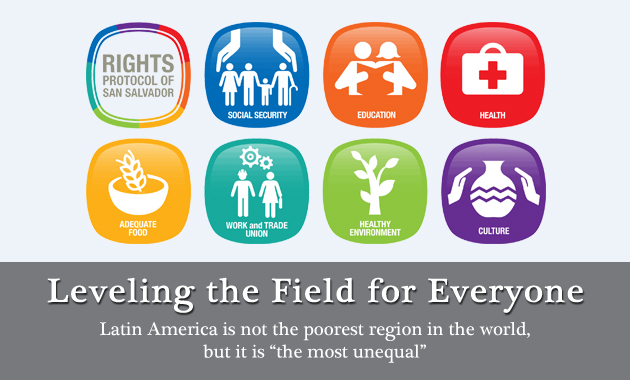- English
- Español
Media Center
Feature

The Protocol of San Salvador is a tool that protects economic, social and cultural rights for citizens of the hemisphere.
Sixteen countries to date have ratified the Protocol and are obligated to present information every three years to verify the degree of compliance with the rights contained in the Protocol.
The reports present a detailed picture of the current situation for each of the rights covered.
The first round included the rights to social security, education, and health, areas in which several countries have already made progress and in some cases, setbacks.
November 13, 2017
Latin America is not the poorest region in the world, but it is “the most unequal”—a reality on which many governments, organizations, and individuals have focused their concern. From an institutional standpoint, the OAS has been promoting the “More Rights for More People” slogan not just as a maxim, but as a means to “level the field for everyone.”
It is precisely in that spirit that the people who are working today to transform into reality the commitments made by countries in an International Covenant, of binding nature, known as the Protocol of San Salvador, do so. The Protocol establishes a set of duties that 19 states of the Hemisphere have signed to adopt related to economic, social, and cultural rights, including in particular the rights to social security, education, health, food, work and trade unions, a healthy environment, as well as to the benefits of culture.
The Protocol, adopted in 1988, serves as the basis for tracking the progress made on these issues that have a direct impact on achieving greater equity in the region. To date, ratifications have been received from 16 States Parties. Within the framework of the OAS, and as the work of the group of experts that make up the monitoring mechanism, a number of indicators that countries must report to be evaluated. These indicators not only make it possible to report on progress made, but also to receive the support and recommendations of experts in order to continue advancing in the areas where significant gaps remain.
Through national reports, states that are parties to the Protocol deliver data on each progress indicator, i.e., they make public the measures and strategies they have taken to guarantee these rights, as well as the impact they have had. But the process does not end there. A group of experts that make up the Working Group for the Analysis of the reports provided in the Protocol of San Salvador, analyze the information and make observations and recommendations to seek to promote each State’s continued advancement to fulfill its obligations, design and apply their public policies with a rights-based approach.
Some achievements
“What we expect primarily with these follow-up mechanisms is that through detailed information collection, the breakdown of data, and the devising of specific indicators, countries will be able to better identify how people—especially among traditionally discriminated populations—are living. Populations that are not included in statistics remain invisible populations.”
Rosa María Ortíz
former IACHR Commissioner and Expert of the Working Group to Examine Progress Reports of States Parties to the Protocol of San Salvador (2012-2015)
The reporting process has already begun and includes rights to social security, health, and education. Today, thanks to the intensive work of the Working Group, it is possible to observe significant progress in 7 of the 16 countries that are participating in this process to date, such as:
- On the issue of social security in Uruguay, there was an increase in the number of participants from 73% in 2009 to 80% in 2011. That increase had an impact not only on coverage, but also on reducing the gender gap.
- It is also worth noting that today in Uruguay educational coverage includes almost all children (girls and boys) between the ages of 6 and 11, and that it has been extended to 5-year-old children and to adolescents between the ages of 12 and 13.
- Colombia’s report reflects the creation of the Social Security System, which requires all employers to register their male and female workers in the system.
- On the issue of health, Bolivia reported that the infant mortality rate declined from 52 to 40 deaths per 1,000 live births between 2006 and 2011; in the same period, the mortality rate among children under 5 years of age fell from 65 to 51 per 1,000 live births.
- Bolivia also reported the creation of the unit on intracultural and multilingual policies, a regionalized curriculum that incorporates into its plurinational education system knowledge, visions of the cosmos, values, and histories of the indigenous nations and peoples, as well as the publication of indigenous languages’ alphabets.
These are just a few examples. However, one of the major contributions of this reporting system is the use that each country can make of the reports. Examples of government initiatives that have guaranteed advances in the exercise of rights, serve as an example and a model to their neighbor countries in the Hemisphere.
Some Challenges
The challenges to achieving greater access to economic, social, and cultural rights are guaranteed not only in the structural, access or policy-making area. The system of indicators of the Protocol has revealed that measuring and breaking down data by gender, race, sexual identity, age, geographic area, is a key element toward a true “universalization” of these rights.
Many of the recommendations that the Working Group submits to each country indicate the lack of more accurate data reflecting, for instance, how many girls in rural areas or from low-income families have benefited from the increase in education coverage in some remote region of the Hemisphere. It is the only way we can measure and ensure that our effort toward achieving more rights for more people is being effective for all.
Reference: E-054/16


